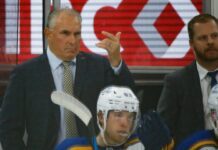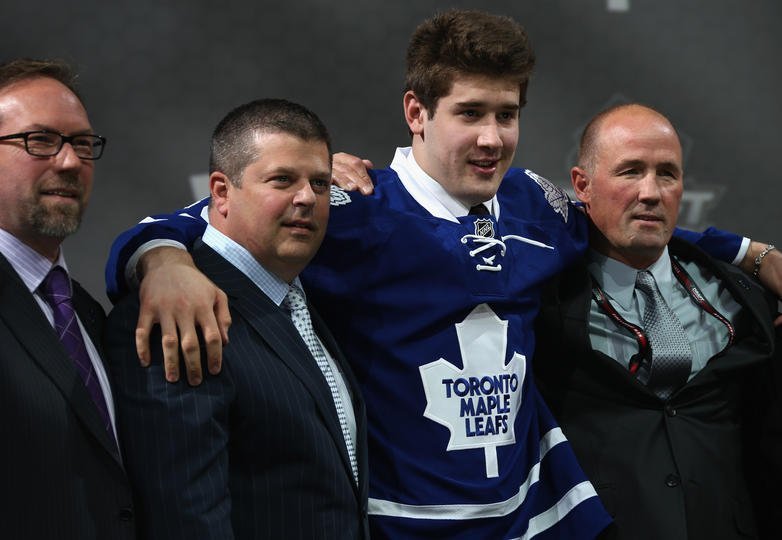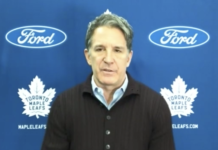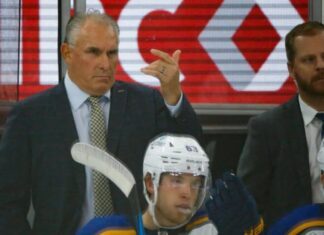Part Two of Anthony Petrielli’s interview with Toronto Maple Leafs Director of Amateur Scouting Dave Morrison focuses on the scouting process, touching on the logistics of running one of the League’s larger scouting staffs as well as the role of statistics and third-party information. To read Part One, click here.
Anthony Petrelli: How long is your draft process and what all goes into it?
Dave Morrison: It’s the whole year. In many cases it’s their underage year. We all start out with a list from the year before which has basically been started by the reports you do on them as underage players. You already have some framework on a numerical basis based on your rankings and ratings, so typically you have reports on most of the top kids because the good kids play up an age group, or you’re able to see them in the better leagues and they catch your eye. The good kids always catch your eye. In the case of Connor McDavid, it feels like he’s been on the scene forever now. Then, it just starts again. At the start of the year, you have that framework you know from the year before. It’s a yearlong process and it starts with the part-time scouts getting more viewings on them because they’re local to their team or in that area; then it goes to the regional full-time, then the crossover guys, then myself. So it’s a yearlong process. Sometimes two.
AP: Does your staff put any time into when young players are in the GTHL, etc.? Maybe it’s a coincidence, but I’ve noticed you’ve drafted a few guys who were higher in the OHL priority draft than they were in the NHL draft; for example, Greg McKegg was drafted 2nd overall, I believe. Sam Carrick was a 1st rounder. Do you guys watch them at all when they’re that young?
DM: Not typically, to be honest. Some of us may have seen them, but not too often. It’s just too tough to schedule those types of things. The OHL Cup has become a little more important; we’ve had guys there watching that. That’s in their minor midget year, their draft year into the OHL. That’s because it’s a little bit more important and seems to get scouted a little more from the NHL side of things. Beyond that, it’s pretty tough to get out and watch those kids as well. Sometimes you just happen to be in a place where there’s a midget tournament and you’ve heard of a player, so you go over and sneak a peek. I know I snuck a peek at Sean Day a couple of years ago, who was given the exceptional status and ended up in Mississauga this year. I just happen to be at a game and there was a minor midget tournament on another rink in the complex, so I went over and snuck a peek at him because I had heard quite a bit about him. Sometimes you’re fortunate to be able to do that, but otherwise it is fairly tough. In a kid like Connor McDavid’s case, there was so much being said about this young guy that everybody is trying to sneak a peek, I think.
AP: I’ve read that you guys have one of the highest number of scouts in the league; you’re right up there.
DM: We have a larger staff, I’d say. I don’t think we’re the largest staff, but we have a larger staff.
AP: How do you go about managing that? On one hand there’s more eyes on more players, but I assume there’s friction about the board with more hands on deck. There’s challenges in that.
DM: It’s a bit of a bureaucratic system. Every scout reports to another scout. We have it all charted out for every hockey area — In Canada you can go East, Ontario, West, and then we have US East and US West. In Europe we have Scandinavia and Russia. In every area we have a part-time guy and a full-time regional guy. Between those two guys there’s a lot of coordination that has to take place in terms of viewings, coverage, rankings, so that the crossover scouts are able to schedule and come into every area and see all these players. In that regard, we do a lot of regional meetings and we require that each region has a meeting every month and puts a list together, so that I know who their top guys are and from month to month how it’s changing.
AP: Some people take it a little overboard. I was reading an article after the Shanahan hire and a columnist was saying the Leafs should hire a boatload of new amateur scouts to scout the edges of the Earth — it seems unreasonable to think you would be able to manage so many scouts full time.
DM: There’s some people in the scouting business who think smaller staffs are a lot more ideal. There’s less opinions, so if you hire the right people you don’t need that many. I think you can have a larger staff, and have the right people as well, and have a certain level of communication. I’ve tried to make it so that our scouting staff is a team. We work in unison and we have our own little team that has to be on the same page. That’s what I’ve tried to do with our staff. I really like the group that we have.
AP: So, the dynamic with the part-time and full-time is that they’re all watching games and if the part time guys see someone, they’ll report to the full-time guy and bring them over to see him?
DM: Exactly, yes. There’s a lot of coordination. They talk weekly. In each area, the full times and the part times talk weekly and they submit an ABC list. Each week, they go over which players went up or down and then they submit that to our guy who puts our watchlist together. Then, he’ll make the changes accordingly and it gets sent out to each of the crossover scouts and back to each of the regional full-time guys. We make a notation on who has moved up or down, so we’re aware of any changes or if it’s stayed the same.
AP: When you say that you spend a lot of time on players in the year before their draft year, is the way it works is that you sort of weight it toward their progression?
DM: Definitely. I always have scouts at the U17 World Championship, which I think is in Sarnia this year in November. The guys who go there do a full report. I can see where they have ranked them and rated them, what they thought of them, and what type of game they bring. We’ve got all that information and all the reports on different guys from each player’s area; our scouts will have done reports on them and we’ll have all those reports as well. That’s what we’re doing, we’re trying to determine if a player is headed in the right direction.
AP: You guys have drafted a number of players who have had a good second half to their draft year. Josh Leivo would be one. I’d imagine that’s a big thing, that they’re continuing to grow.
DM: We can’t forget that aspect. They’re just kids and sometimes they don’t stop growing until they’re 19 or 20. Sometimes it all of a sudden physically kicks in and you just don’t know when that is going to happen. The coordination and the strength all of a sudden hit them and they can start to play their game. Sometimes you have to be ready for that, it can change at any time with a player.
AP: Do you guys ever read up on independent scouting services like McKeen’s to get opinions on players?
DM: For sure. If you ignore information you are doing yourself and your organization a disservice. You have to believe in what your scouts and what you yourself see, but I think you should pay attention to other sources. I think it’s important to have an open mind, and maybe sometimes you’ve missed something or you need to double check something. Some of these other services work hard at it; whether you agree with them or not, have a look at it and see what they think. It’s information, so I don’t know why you wouldn’t pay attention to it.
AP: When it comes to scouting these players, I assume you guys get more information… There’s definitely a lack of quality statistics and basic information that you guys could really use. For example, I couldn’t look up time on ice stats; I couldn’t tell you how much Gauthier was playing per night. Do you guys get other information sent to you that isn’t publicly available?
DM: Basically, when you’re at a game you have a pretty good idea, watching a higher-end prospect, how many minutes they’re getting. When it comes to our own guys that we have drafted, we may get information from our own individual teams. They’ll send it to Jimmy Hughes or myself, things like time on ice. Usually faceoff statistics are publicly available, sometimes not; sometimes you get those. Different things — hits, scoring chances — a lot of those different things we can get. Sometimes we can get it on the draft, definitely. That happens too. I think when you’re at a game and you’re scouting and watching, that’s something that you should be paying attention to as a scout.
I think with the NHL, as statistics become part of everyday life in the NHL, we’ll see it filter down to junior. It’s going to be a process, though. Certain things are going to be more important to certain teams and what not, but so much of it now is becoming available to the teams. Once certain things prove themselves as valuable, junior teams will probably start to implement them, too. There’s a cost, these things are going to cost a certain amount of dollars, and once they have proven useful, I think we’ll see junior teams start to use them. It’s going to be a process.
AP: The San Jose Sharks’ director of scouting was saying they have their scouts hand track Corsi for prospects. I don’t know how reliable or useful it is, but they use it. I don’t know if you guys do anything along those lines?
DM: We’ve done some different things. Sometimes we’ll do home and away splits; what type of stats is a player putting up at home versus on the road. We’ve done different things with different players. It can be valuable, and sometimes after the fact — two or three years down the road — it could also prove to be a misleading thing. You just have to remember you’re developing prospects and sometimes it is information you can use to help the player to become better, too. Sometimes defensively, especially at that younger age, you have to take into account where they’ve come from, where they are. If they’re a first year player or a second year player playing junior, or which team are they on? What’s the system that coach is using? How accountable are they defensively? You have to sometimes be careful in how you measure the stats. It’s all a part of the process. It is all a part of that evaluation.
AP: When you send a scout to watch a game, is he just watching the flow of the game, or is he counting things too?
DM: Different scouts have different ways of evaluating a player. Sometimes it can be positive or negative touches with the puck; when a player touches the puck, does he do something positive with it or negative with it? It can be just as simple as that. They can chart that, and all of a sudden you’ve got a kid with 10 positive touches and one negative touch, which is pretty good, and maybe has one assist. The other guy on the other team, the other prospect, has five positive and four negative but has three goals.
AP: How hard it is for you to account for a team’s systems? That definitely has an impact on how a guy plays.
DM: Huge. Certain junior coaches coach a lot more defensively, some of them coach a lot more aggressively. Part of it is taking all of that into account and measuring the kid himself. Is he going to have that capacity to learn and to want to learn and want to adapt and become a better all-around player? That’s part of what we try to do when we’re drafting players. It comes back to that character part of it; if you have kids with good character, they’re going to do what it takes to become NHL players.
AP: I am a big football guy and I was reading about some of what the Seahawks do; they’ve had a lot steals in late rounds over the last few years. One of the big things for them is they try to find an adversity that the kid has had in his life, just to see if he battles. Morgan Rielly would be an example with the surgery in his draft year.
DM: I think there is something to that. I would agree with that philosophy for sure. I’ve seen it enough times where kids who’ve had different things to go through and it bodes well, because it shows that they have — for lack of a better term — thick skin.
AP: Finn would be another one. He got hit by mononucleosis and that year was kind of a lost one for him; not a wasted year, but definitely not a great one.
DM: Finn has had a couple of things and he just seems to bounce back. I’m looking forward to seeing him become a pro here; I think he’s ready.
AP: With Rielly — I know you don’t follow the NHL as intently, but do you think that injury kind of delayed his growth or set him back a bit, even now?
DM: Oh, absolutely. No question that the best is yet to come. Most players who have had those injuries will tell you it can be 18 months before you’re back to normal. Having said that, back to normal also means you’ve missed time to make yourself better. I think, in Morgan’s case, there’s still a lot of growth left in him.
AP: You can kind of see it in his play that he’s scratching the surface. He’ll do things right but just won’t finish the play, or something; it’s there, it’s within reaching distance, but he hasn’t grasped it yet, maybe.
DM: Yeah. Some of that is just being a rookie, too, adjusting to the pace of the game. But I agree with you that he’s just scratching it and hopefully this year he breaks out. He’s doing the right things this summer to get ready.
AP: I’ve noticed a lot of the ranking systems have rated your prospects on the lower end. The Marlies have been contenders for three years — losing to the eventual Champions three years in a row — and a lot of the prospects have won individual awards. Where do you guys think you’re at?
DM: I don’t necessarily like to rank our staff against other staffs. I do believe we’ve been very underrated. I think if you just look at games played and point statistics from the last nine drafts; I believe someone tweeted out that we ranked fifth in games played and tenth in points scored.
AP: Yep, I actually included that in a piece I wrote; 5th in goals and 10th in points.
DM: It’s a case of — sometimes I wonder if the Toronto Marlies are over scouted because of the centrality of the location. Sometimes when scouts see players too often they tend to pick them apart. On the other hand, I can remember talking to someone about this and they didn’t even know who Matt Frattin was at the time. Matt Frattin certainly hasn’t established himself as a player, but he’s got a chance still. They didn’t even really know who Matt Frattin was, and I said, “this kid is scoring goals at North Dakota like crazy, so how can you not know who he is?” To me, sometimes — and I don’t know why it happens — I just know I disagree and I know I believe in the kids we’ve picked and I think we’ve got a good our pool of prospects. We as an organization believe that and that’s the important thing.
AP: That’s the thing with the Leafs, right? Getting a level of scrutiny and criticism other teams wouldn’t get.
DM: And that’s fine. Nothing is going to change until we as an organization establish ourselves as a perennial winner. When we do that, those things will change eventually. Until we do that, there’s always going to be that negativity in that respect. It’s incumbent on us to remain steadfast and it’s incumbent upon our young guys to prove everybody wrong.
Click here to read Part 1 of this interview with Dave Morrison
Click here to read Part 3 of this interview with Dave Morrison






































